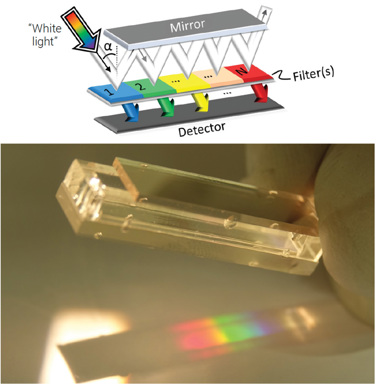 [Enlarge image]Top: Working principle. The folded light path enables reflected light to be used consecutively. Bottom: Unedited photograph of LVF-based module illuminated by a halogen lamp.
[Enlarge image]Top: Working principle. The folded light path enables reflected light to be used consecutively. Bottom: Unedited photograph of LVF-based module illuminated by a halogen lamp.
Filter-based spectroscopic sensors can overcome many limitations of established, grating-based spectrometers, especially in fields outside the laboratory such as agriculture, food and pharmaceuticals. Such filter-based systems are very compact, yet can capture a wide spectral range with high resolution.1 Despite these benefits, however, filter-based systems suffer from fundamental deficits in detection efficiency. In commonly used interference filters, the inefficiency stems from the fact that most of the incident broadband light is reflected (and thus lost), with only a very small portion passing through the narrowband filter.
To improve detection efficiency, the incoming “white” or broadband light can be spectrally divided by beam splitters into partial ray bundles that are then directed to filters transmitting in particular spectral regions.2 Each filter thus receives several times more light than in a system without spectral preselection. Yet such improvements are still far from being optimal, as the complexity, costs and cumulative transmission losses increase with the number of dichroic beam splitters. Another recent approach used two rows of dichroic beam splitters, which slightly reduced transmission losses.3
In recent work, we presented a folded-beam-path architecture to build highly efficient and compact spectral sensors without additional dichroic optics.4 The basic principle combines the ever-present spectral interference filters with a simple mirror aligned parallel to them. The incoming light hits the first filter at a chosen angle of incidence, and the detector captures the specific wavelength region that has passed through this filter. All other wavelengths are reflected and redirected by the mirror to the next filter, which transmits light in a different spectral region. The process continues for all the filters in the setup.
We used two spectral modules to verify the proposed principle. The first module consisted of ten long-pass filters and was capable of detecting the wavelength region of 520–800 nm; this module generated ten bandpass spectral channels with a full width at half maximum of 15–34 nm. The second module was based on a linear variable filter (LVF); with 12 reflections inside this module, it was possible to detect continuous spectra such as those of natural leaves or human skin (spectral range 450–825 nm). Our sensor showed an efficiency increase factor of up to 100 compared with conventional systems that directly illuminate the entire LVF.
We believe that this simple approach enables the design of competitive wearable systems or mobile-phone-integrated spectral sensors with high detection efficiencies.
Researchers
Aliaksei Kobylinskiy, Matthias Kraus and Lukas Werner, University of Applied Sciences Jena, Jena, Germany, and University of Kassel, Kassel, Germany
Hartmut Hillmer, University of Kassel, Kassel, Germany
Robert Brunner, University of Applied Sciences Jena and Fraunhofer Institute for Applied Optics and Precision Engineering, Jena, Germany
References
1. H. Hillmer et al. Nanomaterials 11, 164 (2021).
2. A. Kobylinskiy et al. Appl. Opt. 59, 2443 (2020).
3. T. Anazawa et al. Sci. Rep. 12, 16518 (2022).
4. A. Kobylinskiy et al. Appl. Opt. 61, 9996 (2022).
